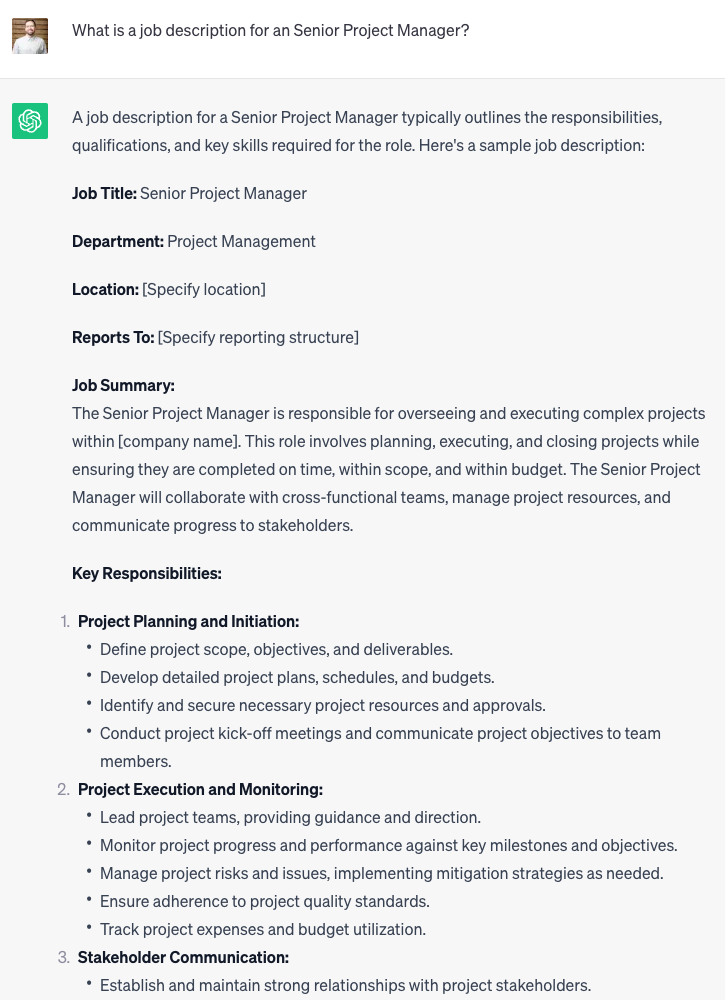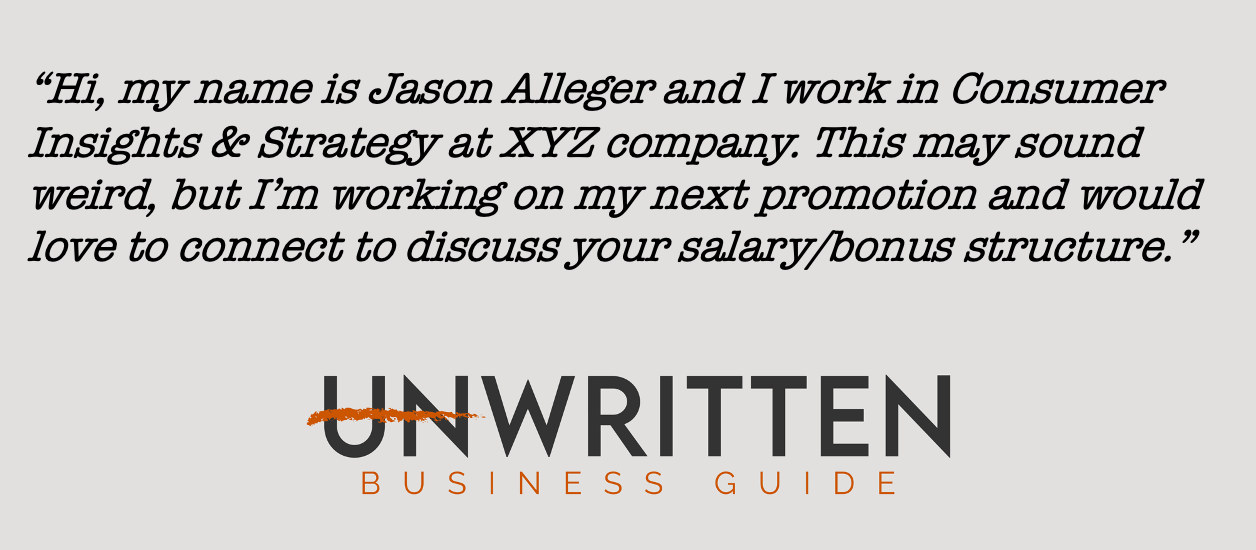The 5 surprisingly easy steps in getting a new title and pay raise
I once had an employee who was amazing. She did everything she was asked, was constantly learning, and added real value to the company. When she came to me with a list of everything she had done (+ the quantified impact of her efforts), and a plan for her next promotion, it was impossible to not grant her a promotion. Here’s how to do exactly what she did.
Step 1: Identify Your Next Role (5 Minutes)
This seems obvious, but you need to clearly define what your next role is. Here’s some examples:
Next Role Definition
- Project Manager → Senior Project Manager
- Social Media Coordinator → Social Media Manager
- FP&A Analyst → Finance Manager
- Circus Manager → Director of Circus Operations
(This last one is how I feel at home with young kids).
Your next role needs to be a clear step forward, but not an unrealistic leap. When determining exactly what your title should be, I recommend researching those job descriptions at other companies. This process is usually very enlightening; for example, when I worked in consumer insights I learned that most elevated roles were in strategy, so I made sure when planning that my title always had strategy as part of it.
This should take ~5 minutes.
Step 2: Create a Document with Your Next Role’s Core Responsibilities (30 Minutes)
Read at least ten job descriptions for your desired title. Here are some sources that are helpful, using the example of a senior project manager:
Core Responsibilities Research Tools
- ChatGPT – Write out “What is the job description of a Senior Project Manager?”
- Monster – Search “Senior Project Manager” and you’ll find real job postings and a template
- TheLadders – this is a recruitment company, so you can see open jobs that aren’t normally posted on sites like Indeed, Monster, etc.

In your document you’re trying to capture the common themes for your next role, with the goal of writing your next job description.
I’ve found in doing this there’s almost always gaps in my experience and what generally is required. It’s easy to brush these off, but you shouldn’t. For example, earlier in my career nearly every promotion required Tableau knowledge, and I had never even heard of Tableau! So at my own personal expense I took some courses, convinced my company to get me a Tableau license, and worked my way into my next job. (See our prior article The Intentional Career for more on this).
This takes ~30 minutes, with the bulk of the time going towards organizing core themes. You should end with a concise 1-pager of your next job description.
Step 3: Write Out What You Have Done + Calculate Your Impact (25 Minutes)
Next, take an inventory of what you have done in your current role. Simply list out the projects first. It should look like this:
Project List
- Project Elephant – led new project, hitting all deadlines
- Project Circus Tent – organized conference, went seamlessly
- Project Peanuts – implemented new system, system now used company-wide
Get the point? It’s really just a summary and you don’t need more detail than this. But here’s where it gets interesting: You’ll add a column for how much that would have cost the company to hire someone externally and the money you saved.

Relative Cost = what it would have cost to hire someone externally to do this same project (if unsure, most consultants charge $50-150/hour)
Savings = what you negotiated, saved with time, or anything else
While this is all debatable with your manager, the point is that you should have a total number higher than what they are paying you. What you’re doing here is quantifying your impact (and making it clear that you are a high ROI for the company). It’s critical that you put this into $’s, because otherwise it’ll be hard to justify any sort of a raise.
Now for a major disclosure: as a manager, this is both amazing and frustrating to get from an employee. Amazing because it forces you to objectively look at their value, but frustrating because most hires are made because the role should return in revenue 10x what you pay that employee. So as you write this, you may feel very entitled to a raise (“look at all this value I’m bringing!”), but please remember that’s why you were hired. The company has been investing in you too so you can do all these things. Basically don’t let your head get too big here.
That being said, this should help quantify your impact and be a useful tool in negotiating for your promotion.
This should take ~25 minutes, and should be very straightforward in the format.
Step 4: Discover Your Next Raise Amount (30 Minutes)
Now to do some research into what your future role typically pays! Here are some sources I recommend:
Salary Research Tools
- Glassdoor – people in your role or company upload what they make
- Bureau of Labor Statistics – the US government shares salaries for over 800 occupations, by state
- Indeed Career Guide – this shows the average salary by role as indicated by employers
Be sure to look at the state you’re in (not nationally). You should write out the low and high, with each source and keep the link. The point here is to use multiple sources to triangulate what your salary should be.
Now for bonus points – you should reach out to others in this role and ask them how much they make. I did this once and it was incredibly insightful. I found other people on LinkedIn who had job titles similar to what I was looking to be promoted into and sent a message that simply said:

I had nearly everyone respond and hop on a call with me. I built a spreadsheet that had their company size, title, time in that role, number of people managed, salary, bonus, and other perks. I shared the document with them in return (with anonymized names/companies), and it was mutually beneficial for everyone.
Between doing some research online and talking to others who are in a similar role it will be very clear what you should be making with your promotion. I’ll also add that it’s important to remember that most of these numbers are averages. If you’re a high performer, work in an industry that typically pays more (e.g., tech), or have some other factor that puts you in the upper tier of your expected pay, be sure to capture that too.
This should take you ~25 minutes to research online, and a bit more time if you reach out to peers.
Step 5: Talk with Your Boss (30 Minutes)
(I fully acknowledge that setting up this meeting is nerve wracking, but you’ll miss 100% of the shots you don’t take.)
At this point you should have the following:
- Your next job title (step 1)
- Core responsibilities job description (step 2)
- Quantifiable table of what you have done / your impact (step 3)
- Salary ranges for your next role by source (step 4)
This should be 3 solid pages to show your boss. Here’s how to prepare for that meeting:
Let your boss know. Send him or her a note or talk with them informing them that in your next 1:1 meeting you’ve prepared some details around your next promotion you’d like to discuss. You can even invite him or her to put some thought into this too, which will make your discussion that much more effective.
Share your documentation. Have two copies printed and walk through it together. Let them ask questions and build upon what you have created. This should be a positive experience. Frame it as a discussion, not a negotiation. Send them a copy after your meeting.
Consider timing. A lot of times it isn’t if you’re going to get a promotion, it’s when. Be mindful of this – you may not be getting a promotion next week, but you have set the stage.
Now as a manager, I’m going to share a secret. Your manager will take your documentation with them to fight for your promotion. When I have had employees do this I literally will make copies and bring these into my bosses’ office and make the same case. I may not agree with all of the numbers, or maybe know it’s not possible yet due to some external factors, but I’ll go to bat. This document will be passed around to many people (so make sure it’s professional and accurate!)
This will take you ~30 minutes to meet with your boss. It’ll take your boss much longer as they share this document around with other decision-makers.
Conclusion
If followed correctly, this may be the most lucrative two hours you will ever spend.
Promotions are a part of business and you should be asking for one if you deserve one. This process can also be enlightening in gaps in your experience/skill set. Best of luck with your next promotion! (And by following this guide, you won’t even need luck!)


